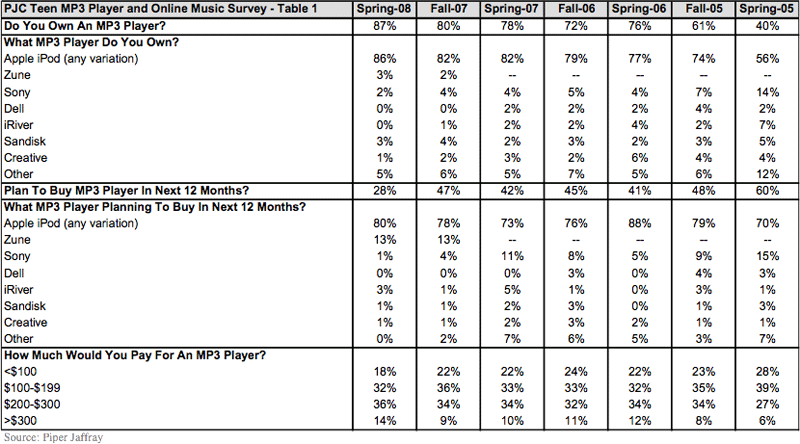Teen iPhone share seen doubling as iPod, iTunes flatten
In the latest round of its semi-annual teen surveys, analyst group Piper Jaffray finds that ownership of Apple's iPhone has doubled in six months and is set to double again, though cooling iPod and iTunes use suggests a changing of the guard.
Crucially, the remaining percentage that plans to buy an iPhone hasn't changed. As with the fall poll, 9 percent of all the teen respondents expect to buy the device sometime within the next six months.
To senior analyst Gene Munster, this potentially signals a trend that doubles Apple's user share once again, with as much as 12 percent of the same group owning the touchscreen phone by the time of the next survey, in fall 2008. The increase would give Apple more than its desired 10 percent share of the cellphone business, albeit only among younger buyers.
Ownership of its longstanding iPod line is also at a record high since the surveys began tracking the information, Piper Jaffray notes. From those that own an MP3 player, about 86 percent have at least one form of iPod, up from 82 percent half a year before. Overall use of MP3 players is also at a record 87 percent, climbing significantly from 80 percent in the last survey.
iTunes use is also up slightly, with 81 percent of legitimate music downloaders using the Apple-run store versus 79 percent in the last survey. The balance has shifted more towards legal purchases, with 39 percent of the teens choosing to buy downloads rather than simply bootleg them through peer-to-peer networks.
The report suggests to the analysts that Apple has little to fear for its control of the US music business in the short term, especially among its younger customers.
"Apple's dominance in the portable media and online music markets is going seemingly unchecked," Munster observes.
Clouds loom over the news, however, and point to the iPhone potentially dulling the iPod's earlier success. While Apple's command of MP3 players has increased, actual demand for any MP3 player has dropped to its lowest amount in three years — just 28 percent look to buy a new player in the next six months, while 47 percent did in fall 2007.
Moreover, while Apple's share of online music purchases is higher than in late 2007, it remains smaller than all-time highs of 89 and 91 percent set in fall 2007 and spring 2006 respectively. Munster and fellow analysts believe it may the result of more sites offering music without copy protection, permitting iPod owners to buy more of their digital music outside of iTunes.
Nonetheless, the threat is understood to take root more in general market forces than in weaknesses inherent to Apple's own strategy.
Use of non-Apple online stores has dropped from 16 to 13 percent, and any gains by challengers in the MP3 player category primarily come at the expense of others. Microsoft's Zune has become the second most popular, with 3 percent owning the device and 13 percent planning to buy, but the share for virtually all others but Apple has dropped or else remained flat, uncovering a shift rather than a takeover.
"While Microsoft is gaining on Apple, the share growth is coming at the expense of players other than Apple, as Apple's share is growing too," Munster writes. "It is clear to us that Apple has captured the "cool factor" among high school students across America."
 Katie Marsal
Katie Marsal












 Malcolm Owen
Malcolm Owen
 William Gallagher and Mike Wuerthele
William Gallagher and Mike Wuerthele
 Christine McKee
Christine McKee
 William Gallagher
William Gallagher

 Marko Zivkovic
Marko Zivkovic









